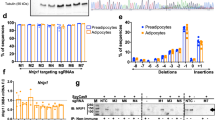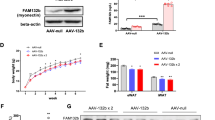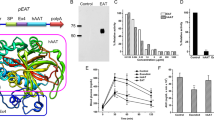Abstract
Commercial anti-obesity drugs acting in the gastrointestinal tract or the central nervous system have been shown to have limited efficacy and severe side effects. Anti-obesity drug development is thus focusing on targeting adipocytes that store excess fat. Here, we show that an adipocyte-targeting fusion-oligopeptide gene carrier consisting of an adipocyte-targeting sequence and 9-arginine (ATS–9R) selectively transfects mature adipocytes by binding to prohibitin. Injection of ATS–9R into obese mice confirmed specific binding of ATS–9R to fat vasculature, internalization and gene expression in adipocytes. We also constructed a short-hairpin RNA (shRNA) for silencing fatty-acid-binding protein 4 (shFABP4), a key lipid chaperone in fatty-acid uptake and lipid storage in adipocytes. Treatment of obese mice with ATS–9R/shFABP4 led to metabolic recovery and body-weight reduction (>20%). The ATS–9R/shFABP4 oligopeptide complex could prove to be a safe therapeutic approach to regress and treat obesity as well as obesity-induced metabolic syndromes.
This is a preview of subscription content, access via your institution
Access options
Subscribe to this journal
Receive 12 print issues and online access
$259.00 per year
only $21.58 per issue
Buy this article
- Purchase on Springer Link
- Instant access to full article PDF
Prices may be subject to local taxes which are calculated during checkout





Similar content being viewed by others
References
Rosen, E. D. & Spiegelman, B. M. Adipocytes as regulators of energy balance and glucose homeostasis. Nature 444, 847–853 (2006).
Ouchi, N., Parker, J. L., Lugus, J. J. & Walsh, K. Adipokines in inflammation and metabolic disease. Nature Rev. Immunol. 11, 85–97 (2011).
Cinti, S. The adipose organ. Prostaglandins Leukot. Essent. Fatty Acids 73, 9–15 (2005).
Elangbam, C. S. Review paper: Current strategies in the development of anti-obesity drugs and their safety concerns. Vet. Pathol. 46, 10–24 (2009).
Schaffler, A., Scholmerich, J. & Salzberger, B. Adipose tissue as an immunological organ: Toll-like receptors, C1q/TNFs and CTRPs. Trends Immunol. 28, 393–399 (2007).
Ahima, R. S. Central actions of adipocyte hormones. Trends Endocrinol. Metab. 16, 307–313 (2005).
Cooke, D. & Bloom, S. The obesity pipeline: Current strategies in the development of anti-obesity drugs. Nature Rev. Drug Discov. 5, 919–931 (2006).
Nawrocki, A. R. & Scherer, P. E. Keynote review: The adipocyte as a drug discovery target. Drug Discov. Today 10, 1219–1230 (2005).
Stenkula, K. G. et al. Human, but not rat, IRS1 targets to the plasma membrane in both human and rat adipocytes. Biochem. Biophys. Res. Commun. 363, 840–845 (2007).
Watanabe, M. et al. Regulation of PPAR gamma transcriptional activity in 3T3-L1 adipocytes. Biochem. Biophys. Res. Commun. 300, 429–436 (2003).
Cao, L. et al. Molecular therapy of obesity and diabetes by a physiological autoregulatory approach. Nature Med. 15, 447–454 (2009).
Dhillon, H. et al. Central leptin gene therapy suppresses body weight gain, adiposity and serum insulin without affecting food consumption in normal rats: A long-term study. Regul. Pept. 99, 69–77 (2001).
Chen, G. et al. Disappearance of body fat in normal rats induced by adenovirus-mediated leptin gene therapy. Proc. Natl Acad. Sci. USA 93, 14795–14799 (1996).
Won, Y. W., Yoon, S. M., Lee, K. M. & Kim, Y. H. Poly(oligo-D-arginine) with internal disulfide linkages as a cytoplasm-sensitive carrier for siRNA delivery. Mol. Ther. 19, 372–380 (2011).
Won, Y. W., Kim, H. A., Lee, M. & Kim, Y. H. Reducible poly(oligo-D-arginine) for enhanced gene expression in mouse lung by intratracheal injection. Mol. Ther. 18, 734–742 (2010).
Wilson, D. S. et al. Orally delivered thioketal nanoparticles loaded with TNF-alpha-siRNA target inflammation and inhibit gene expression in the intestines. Nature Mater. 9, 923–928 (2010).
Mok, H., Lee, S. H., Park, J. W. & Park, T. G. Multimeric small interfering ribonucleic acid for highly efficient sequence-specific gene silencing. Nature Mater. 9, 272–278 (2010).
Jeong, J. H., Kim, S. H., Christensen, L. V., Feijen, J. & Kim, S. W. Reducible poly(amido ethylenimine)-based gene delivery system for improved nucleus trafficking of plasmid DNA. Bioconjug. Chem. 21, 296–301 (2010).
Hyun, H. et al. Therapeutic effects of a reducible poly (oligo-D-arginine) carrier with the heme oxygenase-1 gene in the treatment of hypoxic-ischemic brain injury. Biomaterials 31, 9128–9134 (2010).
Kolonin, M. G., Saha, P. K., Chan, L., Pasqualini, R. & Arap, W. Reversal of obesity by targeted ablation of adipose tissue. Nature Med. 10, 625–632 (2004).
Mishra, S., Murphy, L. C., Nyomba, B. L. & Murphy, L. J. Prohibitin: A potential target for new therapeutics. Trends Mol. Med. 11, 192–197 (2005).
Patel, N. et al. Rescue of paclitaxel sensitivity by repression of Prohibitin1 in drug-resistant cancer cells. Proc. Natl Acad. Sci. USA 107, 2503–2508 (2010).
Sharma, A. & Qadri, A. Vi polysaccharide of Salmonella typhi targets the prohibitin family of molecules in intestinal epithelial cells and suppresses early inflammatory responses. Proc. Natl Acad. Sci. USA 101, 17492–17497 (2004).
Kim, T. I., Ou, M., Lee, M. & Kim, S. W. Arginine-grafted bioreducible poly(disulfide amine) for gene delivery systems. Biomaterials 30, 658–664 (2009).
Kumar, P. et al. T cell-specific siRNA delivery suppresses HIV-1 infection in humanized mice. Cell 134, 577–586 (2008).
Furuhashi, M. & Hotamisligil, G. S. Fatty acid-binding proteins: Role in metabolic diseases and potential as drug targets. Nature Rev. Drug Discov. 7, 489–503 (2008).
Wang, P. et al. Profiling of the secreted proteins during 3T3-L1 adipocyte differentiation leads to the identification of novel adipokines. Cell. Mol. Life Sci. 61, 2405–2417 (2004).
Veiseh, O. et al. Cell transcytosing poly-arginine coated magnetic nanovector for safe and effective siRNA delivery. Biomaterials 32, 5717–5725 (2011).
Ter-Avetisyan, G. et al. Cell entry of arginine-rich peptides is independent of endocytosis. J. Biol. Chem. 284, 3370–3378 (2009).
Vazquez, E., Ferrer-Miralles, N. & Villaverde, A. Peptide-assisted traffic engineering for nonviral gene therapy. Drug Discov. Today 13, 1067–1074 (2008).
Uysal, K. T., Scheja, L., Wiesbrock, S. M., Bonner-Weir, S. & Hotamisligil, G. S. Improved glucose and lipid metabolism in genetically obese mice lacking aP2. Endocrinology 141, 3388–3396 (2000).
Acknowledgements
This work was partially supported by grants from the National Research Foundation of Korea (2013030789), the Brain Korea 21 plus program (22A20130011095), and the Korean Health Technology R&D project through the Ministry of Health & Welfare (HI13C-1938-010013). All the confocal microscopy and Cellvizio imaging experiments were carried out at Korea Basic Science Institute, Chuncheon Center, Chuncheon-city, Korea. We are sincerely grateful for their assistance in performing experiments and data analysis.
Author information
Authors and Affiliations
Contributions
Y-W.W., P.P.A. and Y-H.K. designed the experiments. P.P.A. and H.J.K. carried out in vitro experiments. Y-W.W., K.S.L., H.J.K. and P.P.A. carried out in vivo animal experiments. K.S.L. and J.K.K. contributed to immunoprecipitation, SDS–PAGE, western blotting, FACS assay and in vivo tissue imaging. Y-W.W., H.J.K., K.S.L., J.K.K., P.P.A., and Y-H.K. prepared the manuscript. Y-H.K. provided overall intellectual guidance and was the principal investigator of this group.
Corresponding author
Ethics declarations
Competing interests
The authors declare no competing financial interests.
Supplementary information
Supplementary Information
Supplementary Information (PDF 3718 kb)
Supplementary Information
Supplementary Movie S1 (MPG 3594 kb)
Supplementary Information
Supplementary Movie S2 (MPG 1538 kb)
Supplementary Information
Supplementary Movie S3 (MPG 2406 kb)
Supplementary Information
Supplementary Movie S4 (MPG 1314 kb)
Supplementary Information
Supplementary Movie S5 (MPG 518 kb)
Supplementary Information
Supplementary Movie S6 (MPG 3534 kb)
Supplementary Information
Supplementary Movie S7 (MPG 36 kb)
Supplementary Information
Supplementary Movie S8 (MPG 70 kb)
Rights and permissions
About this article
Cite this article
Won, YW., Adhikary, P., Lim, K. et al. Oligopeptide complex for targeted non-viral gene delivery to adipocytes. Nature Mater 13, 1157–1164 (2014). https://doi.org/10.1038/nmat4092
Received:
Accepted:
Published:
Issue Date:
DOI: https://doi.org/10.1038/nmat4092
This article is cited by
-
Trilobatin Ameliorates Inflammatory Response by Regulating the miR375-Mediated Fatty Acid Binding Protein 4 Expression in Adipocytes
Revista Brasileira de Farmacognosia (2023)
-
Metformin booster adipocyte-targeted gene therapy for the treatment of obesity and related metabolic syndromes
Science China Chemistry (2022)
-
Photoacoustic molecular imaging-escorted adipose photodynamic–browning synergy for fighting obesity with virus-like complexes
Nature Nanotechnology (2021)
-
Strategies for Browning Agent Delivery
Pharmaceutical Research (2021)
-
Non-viral gene delivery systems for tissue repair and regeneration
Journal of Translational Medicine (2018)



